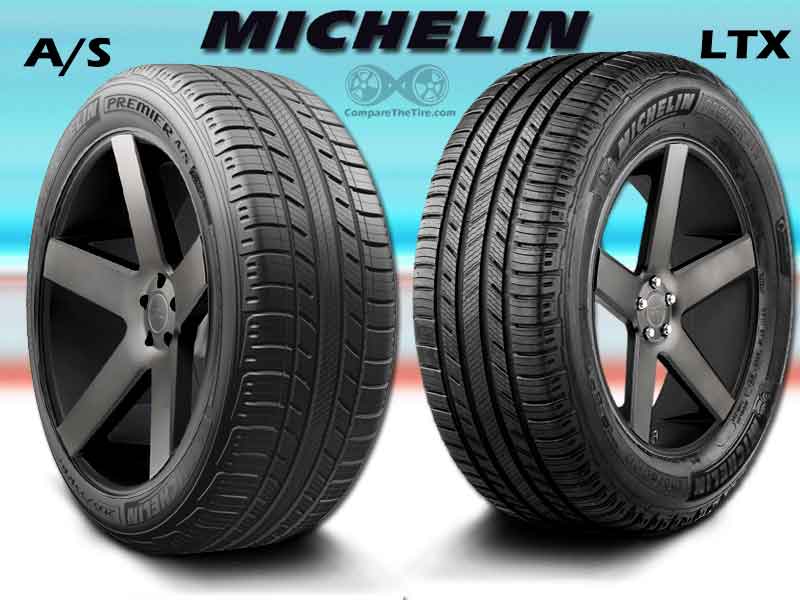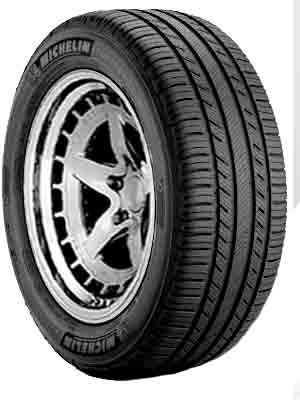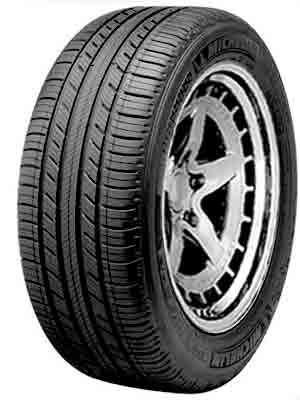Michelin Premier LTX vs Premier AS: These are both all-season tires from the Michelin Premier tire series. They perform year long and show optimized performance on both dry and wet pathways. Moreover, their enhanced tread composition results in a reliable driving experience in winter conditions, even on the soft snow.
Michelin LTX shows a compact, directional and symmetrical tread design. Its performance on dry road ranks it superior to the competitor. Besides that, you can enjoy driving in the rain because its wave-like sipes and longitudinal grooves safeguard against aquaplaning. It comes with manufacturer warranties for mileage, uniform tread wear, and material or workmanship defects.

Examine the treads on these tires closely. They hold the key to knowing which to choose. In fact if you visit my "tread design" page, picking the right tire would never bother you.
Premier AS is relatively open and aggressive due to a higher number of grooves and bold sipes. That’s why its wet performance is even better than its competitor. You can also use this tire for driving during the light snowfall without losing traction. Plus, it has the economic benefit of lesser fuel consumption.
As compared with Michelin LTX, Premier AS offers superior snow traction, better resistance to aquaplaning, lesser rolling sound, and higher fuel efficiency but its dry traction is comparatively minor and it also comes for a higher price.
Table of Contents
Side By Side Comparison
Michelin Premier LTX

Michelin Premier AS

Both tires were tested with following specs:
| Premier LTX | Premier AS | |
| Tested size | 235/60R18 SL | 235/60R18 SL |
| Tread depth | 8.5/32’’ | 8.5/32’’ |
| Tread width | 7.8’’ | 7.3’’ |
| Section width | 9.5’’ | 9.4’’ |
| Load speed rating | 103H | 103H |
Tread Comparison

LTX characterizes a compact tread design having three circumferential ribs, four longitudinal grooves and bulky shoulders. Central ribs have wave-like sipes while shoulder blocks have linear sipes. There are numerous lateral grooves in both shoulders but no complete horizontal spacing is present in the ribs. However, incomplete notches at the edges of ribs form a few narrow lateral voids. Due to these features, its contact patch becomes comparatively larger. Nonetheless, the tread depth is the same for both these tires.

The tread pattern of AS is similar to its competitor as both of these belong to the same tire series. However, a narrow longitudinal groove passes through its middle rib and its sipes and notch-like lateral voids are also more prominent and wider. Its shoulder blocks also have a narrow longitudinal groove passing through them but their size and the number of lateral grooves among them are almost identical to the competitor. Its siping pattern is relatively prominent specifying zigzag sipes on the central ribs and linear ones on the shoulders. Due to additional grooves, bold sipes and wide lateral voids it has a higher void ratio than its contestant.
Tire Performance Comparison
| LTX | AS | |
| Hydroplaning resistance | Moderate | High |
| Rolling resistance | Moderate-high | Moderate |
| Off roading ability | low | Low-Moderate |
| Durability | Moderate-high | High |
Road Grip Comparison
The dry grip of LTX is stronger in comparison due to its bulkier tread. Its contact patch is higher as it has a narrow longitudinal groove passing through its middle rib and the horizontal voids among the marginal ribs are also comparatively wider. Due to these features, its tread holds on the road more firmly. However, a low void ratio brings its position lower when the talk is about wet or ice grip. As hydroplaning efficiency is reduced by smaller sipes and decreased water holding capacity of its grooves, its tread presents a relatively lesser grip on a wet road. On snowy pathways, its grip is lesser than the competitor because the low void ratio provides decreased traction on soft snow.
Premier AS gets a lower score for its grip on a dry track because the longitudinal channel at the center of the tread and relatively broad voids in ribs render its contact patch lower. As a result, a lesser surface area of tread makes direct contact with the ground and the grip is reduced. But these voids and bold zigzag sipes are beneficial when driving on a wet or icy pathway because they remove the water from the pavement and allow the tread to grip easily. Hence, it shows a better wet and ice grip than its competitor. Its snow traction is also better because the extensive void capacity and bold zigzag sipes grip over the snow more firmly.
| LTX | AS | |
| Dry Grip | High | Moderate |
| Wet/Ice Grip | Moderate | Moderate-High |
| Snow Grip | Moderate | High |
Handling Comparison
These tires come on par for handling proficiency on dry tracks because they have the same sized shoulders. Thus, their ability to maintain a stable grip on the pavement is also equal. On wet and icy pavements, LTX gets a lower score for steer management because its sipes are less bold and it lacks narrow circumferential grooves in the shoulders. This feature also reduces its handling efficiency on the snow-covered path because the biting ability of shoulders on snow is minimized by low void ratio.
On the other side, bold sipes and vertical channels passing through shoulder blocks allow Premier AS to maintain the traction on the wet or iced pathway as water is wiped off by these voids. Similarly, these additional grooves increase snow biting, making the handling response more precise.
| LTX | AS | |
| Dry Handling | High | High |
| Wet/Ice Handling | Moderate | High |
| Snow Handling | Moderate | Moderate-High |
Comparison of Hydroplaning Resistance
AS gives better protection from hydroplaning, owing to the benefit of its high void ratio. In addition to wide circumferential grooves, it has three additional relatively narrow longitudinal channels; one in the center and two passing through the shoulders. Moreover, its siping pattern is relatively prominent. Hence, its tread efficiently wipes off water from the road to maintain a steady grip.
In contrast, LTX has a lower void ratio and its sipes are less bold as well. Hence, its tread offers relatively minimized water holding capacity, eventually making its hydroplaning resistivity lesser than its competitor.
Comparison of Rolling Resistance
As LTX has a low void ratio so, more of its surface area comes in contact with the paved surface. Resultantly, it encounters a higher rolling resistance than its competitor. In turn, its fuel efficiency also becomes lower because of increased fuel consumption against road friction.
Premier AS faces lesser rolling friction due to its open tread pattern than the contestant. Prominent voids decrease the contact patch of tread, as a result, lesser friction arises when it rolls over the road. That is why it ranks as a comparatively fuel-efficient tire.
Comparison of Noise and comfort
LTX ranks higher for comfortable driving on a dry road but ranks lower for noise production and ride comfort on a wet track. The reason for more stable driving on the dry road is its better dry traction but as its wet grip is relatively minor, driving on wet pavements becomes uncomfortable in comparison. Its noise production is higher because wind can easily circulate through its shoulder grooves as well as longitudinal channels.
On the other side, AS provides a comfortable driving experience on the wet road and makes lesser rolling noise. Its efficient hydroplaning resistance accounts for stable road traction and a comfortable ride when travelling in rainy conditions. Moreover, its tread is constructed according to Michelin Comfort Control technology which decreases the production of tire noise.
| LTX | AS | |
| Noise | Moderate- high | Moderate |
| Driving comfort on a dry road | High | Moderate |
| Driving comfort on a wet road | Moderate | High |
Tread Composition
Both Premier tires specify the same rubber compound and tread construction technologies. Their rubber polymer is formulated according to EverGrip technology which includes silica enhancements for more responsive handling and sunflower oil for making tread flexible, resulting in better performance in lower temperatures.
Internally, the steel carcass is built from twin high-strength steel belts with reinforcement by a hybrid aramid-nylon compound. On top of this is a casing of polyester compound.
| LTX | AS | |
| Tread composition | Robust polyester cord, Hybrid nylon-aramid reinforcement, Silica and sunflower enhancements | Robust polyester cord, Hybrid nylon-aramid reinforcement, Silica and sunflower enhancements |
| Rim Structure | Twin high-strength steel belts | Twin high-strength steel belts |
Durability and treadwear
As both of these tires have the same tread composition their tread wear is also very similar. Likewise, the mileage warranty from the manufacturer is also equal for both these tires. However, Premier AS gets a relatively higher score for durability as its UTQG rating is higher. Also, its tread pattern gives rise to lesser rolling friction. Thus, its tread is consumed relatively slowly.
Premier LTX has a good but relatively lower UTQG rating which renders it less durable in comparison. The high void ratio also adds to its slower wear as it faces minor rolling resistance.
| LTX | AS | |
| UTQG | 620 B A | 640 A A |
| Treadwear warranty | 6 year/ 60,000 miles | 6 yrs/ 60,000 miles |
| Uniformity warranty | For one year, first 2/32’’ | For one year, first 2/32’’ |
| Workmanship warranty | 6 yrs | 6 yrs |
Price
Premier AS costs higher in comparison. However, its superior hydroplaning resistance, wet grip and low rolling sound are a good justification for the higher price. Its price varies from $245 to $285 for the tested size.
Conversely, LTX gives you reliable wet traction and optimized performance on the dry road within a lower price range. The tested size is priced from $210 to $250.
Quick Summary
Both of these are all-season tires.
Premier AS;
- provides higher safety from hydroplaning.
- offers enhanced snow traction.
- is a less noisy tire in comparison.
- ranks higher for durability.
Michelin LTX;
- shows a better dry grip on the comparison.
- is available for a lower price than its competitor.
has the same warranty as the contestant.



